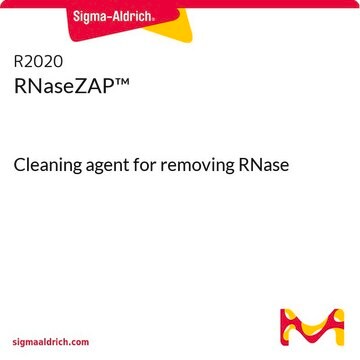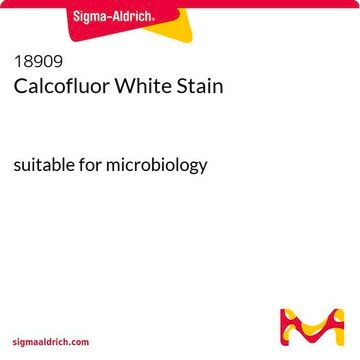DEPC can be solubilized in 95% ethanol, e.g. 1.6 mL in 4 mL ethanol gives a clear, colorless solution. DEPC is soluble in alcohols, esters, ketones and other hydrocarbons, but has limited solubility in water (~0.1%). 6 DEPC hydrolyzes in aqueous solution, to form ethanol and carbon dioxide (CO2). Typically a 0.1% DEPC solution (1 mL of DEPC diluted in water to 1 L) is used to inactivate RNase. The DEPC will not immediately dissolve, as evidenced by the appearance of globules. The mixture should be stirred until the globules disappear. DEPC is sensitive to pH. In phosphate buffer at 25 °C, its half-life is 4 minutes at pH 6, and 9 minutes at pH 7. Hydrolysis is accelerated by Tris buffer,7 where at 25 °C, the half-life of DEPC was reported to be 1.25 minutes at pH 7.5, and 0.37 minutes at pH 8.2. DEPC will decompose in solution when autoclaved. For 0.1% DEPC solutions, autoclaving for 15 minutes per liter should be sufficient.
DEPC is very sensitive to moisture. As such, DEPC is packaged under argon to help reduce exposure to moisture. If DEPC is exposed to even traces of moisture, some hydrolysis occurs. The resulting CO2 is more soluble in DEPC solutions at 2–8 °C than at room temperature. As the product is brought to room temperature before opening, the DEPC can become supersaturated with respect to any dissolved gas. After opening the bottle for the first time and each time thereafter, layer nitrogen or argon gas over the DEPC and store the closed bottle at 2–8 °C for optimal stability. It may be helpful to store the bottle inside a sealed plastic bag with desiccant, but with the bottle cap slightly loose. If the bag inflates at all, this indicates some degree of decomposition with possible pressure build-up. Once opened, the bottle should not be kept for more than 9 months. DEPC decomposes at 155 °C. DEPC is also sensitive to ammonia, which causes decomposition to urethane.
D5758
Diethyl pyrocarbonate
96% (NT)
Synonym(s):
DEP, DEPC, Diethyl dicarbonate, Diethyl oxydiformate, Ethoxyformic acid anhydride
Select a Size
Select a Size
About This Item
Recommended Products
biological source
synthetic (microbial fermentation/ cell culture)
Quality Level
Assay
96% (NT)
form
liquid
refractive index
n20/D 1.398 (lit.)
bp
93-94 °C/18 mmHg (lit.)
density
1.101 g/mL at 25 °C (lit.)
shipped in
wet ice
storage temp.
2-8°C
SMILES string
CCOC(=O)OC(=O)OCC
InChI
1S/C6H10O5/c1-3-9-5(7)11-6(8)10-4-2/h3-4H2,1-2H3
InChI key
FFYPMLJYZAEMQB-UHFFFAOYSA-N
Looking for similar products? Visit Product Comparison Guide
General description
Application
Biochem/physiol Actions
It inhibits the ryanodine binding to ryanodine/Ca2+ receptor channels in skeletal muscle in a dose and time dependent manner and increases the Ca2+ permeability of SR vesicles.[5]
Signal Word
Warning
Hazard Statements
Precautionary Statements
Hazard Classifications
Acute Tox. 4 Oral
Storage Class Code
10 - Combustible liquids
WGK
WGK 3
Flash Point(F)
156.2 °F - closed cup
Flash Point(C)
69 °C - closed cup
Personal Protective Equipment
Choose from one of the most recent versions:
Already Own This Product?
Find documentation for the products that you have recently purchased in the Document Library.
Customers Also Viewed
Articles
Nuclease-free water (or PCR water) is needed in molecular biology to avoid sample degradation during PCR, sequencing, etc. Ultrafiltration provides a quicker, safer, and more sustainable alternative to DEPC treatment when preparing RNase-free and DNase-free water.
-
What is the solubility and solution stability of Diethyl pyrocarbonate, DEPC?
1 answer-
Helpful?
-
-
Is 121 °C - 132 °C of autoclave temperature for more than 15 min enough to degrade DEPC?
1 answer-
DEPC will decompose in solution when autoclaved. For 0.1% DEPC solutions, autoclaving for 15 minutes at per liter at 121 °C.
Helpful?
-
-
What buffers can I use with Product D5758, Diethyl pyrocarbonate (DEPC)?
1 answer-
DEPC reacts with amines, thiols, and alcohols. Any buffer that contains an amine, e.g.., Trizma, should not be used. View this information on the product information sheet (under Documents, above.
Helpful?
-
-
What is the best way to use Product D5758, Diethyl pyrocarbonate, to inactivate RNAse?
1 answer-
Add DEPC directly to the water to yield a 0.1 % solution. Shake vigorously and allow to set overnight at room temperature with the lid loose or incubated for 2 hours at 37 °C. The solution is then autoclaved 15 minutes for each liter.
Helpful?
-
-
How can I tell if Product D5758, Diethyl pyrocarbonate, has degraded?
1 answer-
DEPC breaks down to ethanol and carbon dioxide. The carbon dioxide builds up pressure inside the bottle; when opened, it will degas and/or bubble out of the bottle.
Helpful?
-
-
What type of container should I use to handle Product D5758, Diethyl pyrocarbonate (DEPC)?
1 answer-
Glassware is preferable since some plastics, e.g.., polycarbonate, are known to react with DEPC.
Helpful?
-
-
Why is stirring or shaking necessary when making RNAse-free water for use with Product D5758, Diethyl pyrocarbonate?
1 answer-
DEPC is not very soluble in water. Stirring and/or shaking is necessary to suspend DEPC in water.
Helpful?
-
-
What is the Department of Transportation shipping information for this product?
1 answer-
Transportation information can be found in Section 14 of the product's (M)SDS.To access the shipping information for this material, use the link on the product detail page for the product.
Helpful?
-
-
What is the stability of Product D5758, Diethyl pyrocarbonate, at room temperature?
1 answer-
The material is stable at room temperature as long as it is protected from moisture. We do recommend 2-8 °C for its storage.
Helpful?
-
Active Filters
Our team of scientists has experience in all areas of research including Life Science, Material Science, Chemical Synthesis, Chromatography, Analytical and many others.
Contact Technical Service








